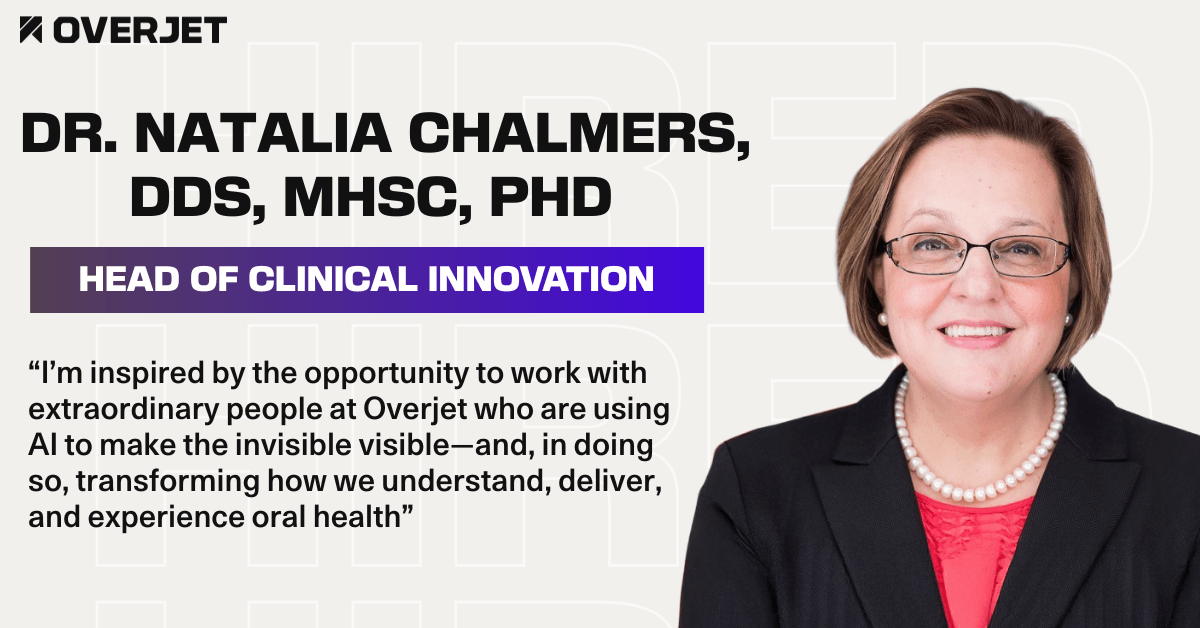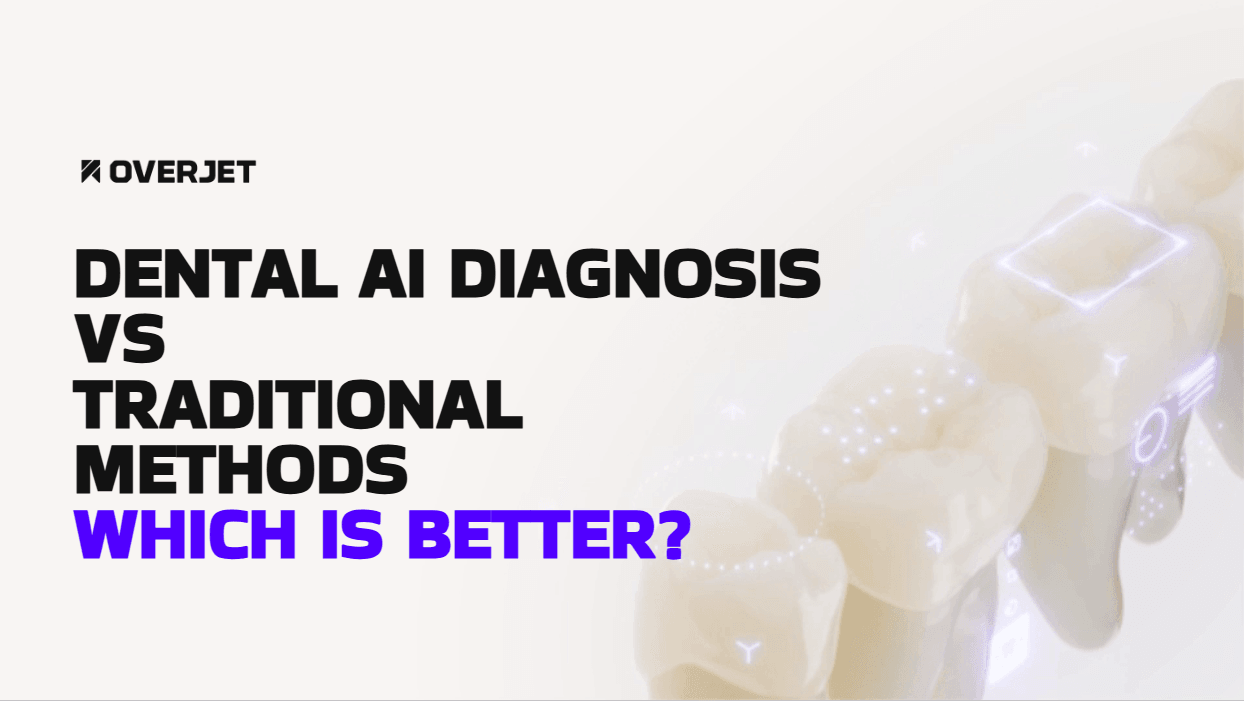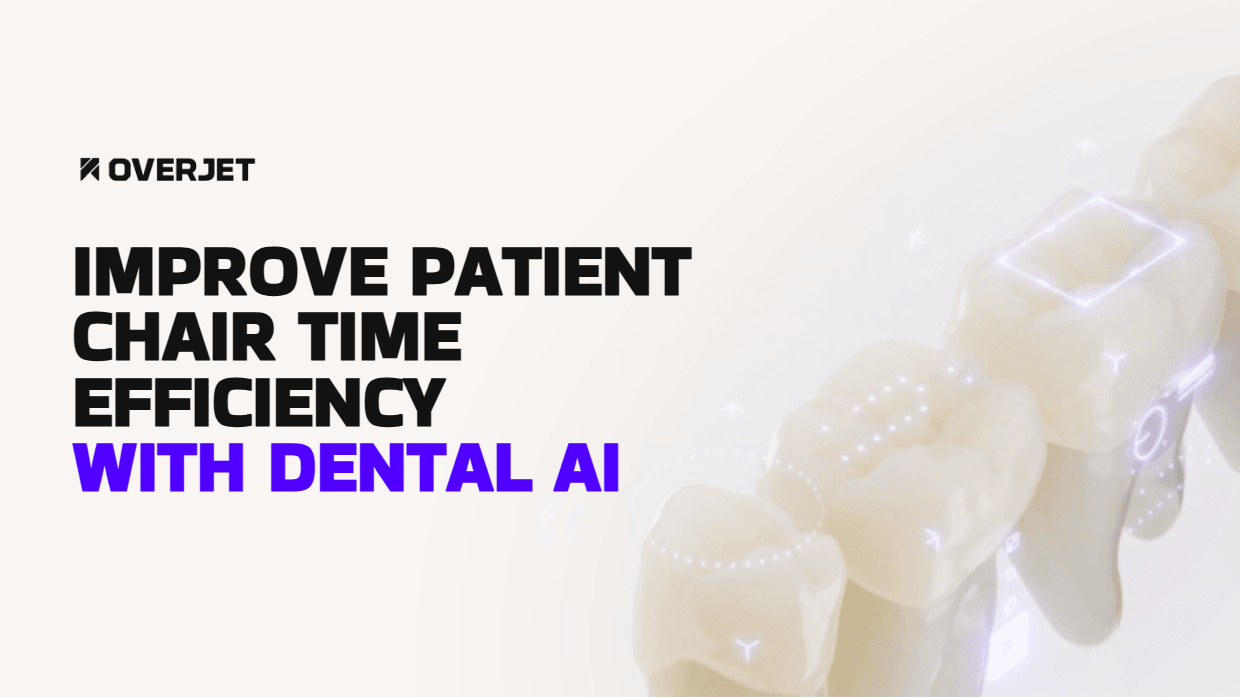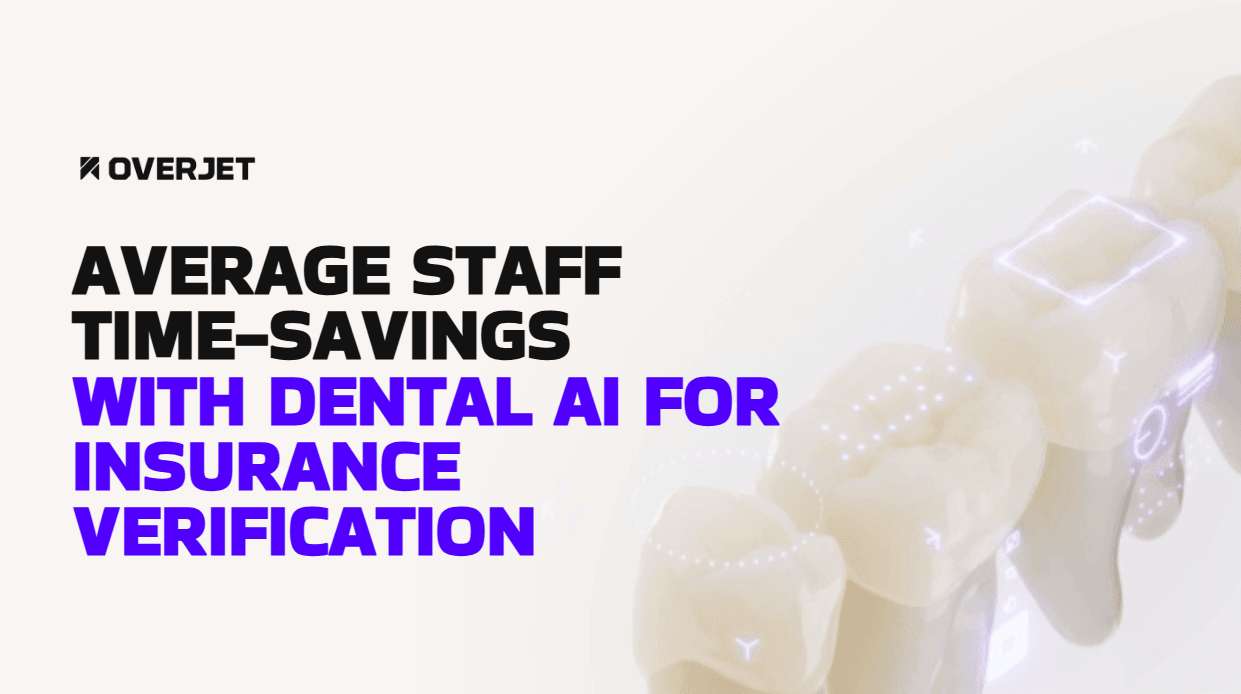Refer to Overjet’s official blog and product documentation for all claims and feature descriptions included in the article.
Insurance verification consumes more staff time than nearly any other administrative task in dental practice operations, yet it remains one of the most error-prone processes affecting both revenue and patient satisfaction. When front-desk teams spend hours on hold with insurance carriers only to receive incomplete or outdated benefit information, the entire practice workflow suffers.
Overjet is the first and only dental AI solution FDA-cleared for both caries detection and bone level measurement, along with its insurance verification capabilities, providing dentists with a comprehensive platform that accurately identifies potential issues while streamlining claim processes in one intuitive interface.
AI-powered verification systems promise to eliminate these bottlenecks by automating eligibility checks and delivering real-time benefit details in seconds. This article examines the specific advantages and limitations of dental AI for insurance verification, implementation considerations, and metrics that demonstrate return on investment.
Explore Overjet's Dental AI Software
What AI-Powered Dental Insurance Verification Means Today
AI-powered dental insurance verification automates eligibility checks by connecting directly to insurance carrier databases and retrieving patient benefit information in real time efficiently. Instead of staff spending 10-15 minutes per patient on hold with insurance companies, AI systems query payer portals and return coverage details, remaining maximums, deductibles, and frequency limitations in under 30 seconds. Rather than requiring extensive manual staff effort, AI-powered solutions can significantly improve the efficiency of insurance verification processes. The technology interprets complex benefit structures and presents them in formats front-desk teams can actually use.
Manual verification has always meant navigating phone trees, waiting on hold, and transcribing information by hand, a process that introduces errors at every step. AI eliminates this friction by querying multiple carriers simultaneously and updating information as policies change throughout the year.
Manual Verification Bottlenecks That Drain Practice Revenue
Traditional insurance verification creates three major problems that directly impact both practice profitability and patient satisfaction.
Increased Administrative Time Per Patient
Front-desk staff typically spend their mornings calling insurance companies, often waiting 5-10 minutes on hold before speaking with anyone. After reaching a representative, they navigate complex benefit structures, verify coverage effective dates, and confirm frequency limitations, all while documenting information that may already be outdated by the time the patient arrives for treatment.
The math becomes staggering quickly. A practice seeing 30 patients daily dedicates 5-7.5 hours purely to verification calls, equivalent to nearly one full-time employee focused solely on this single task. Dental AI can help reduce the administrative burden on staff by automating routine verification tasks.
Higher Eligibility-Related Denials
Outdated or incomplete benefit information leads directly to claim rejections that delay payment and require costly rework. Common verification errors include missing coverage termination dates when patients change jobs, failing to identify waiting periods for major procedures, and overlooking frequency limitations for preventive services.
Each denial requires staff to investigate the discrepancy, resubmit the claim, and wait another 30-45 days for reprocessing. Revenue remains uncollected while the administrative burden multiplies.
Slower Check-In and Patient Dissatisfaction
Patients arriving for appointments expect efficient check-in, yet unverified insurance status creates delays and uncomfortable conversations about payment responsibility. When coverage questions arise at check-in, staff either make patients wait while they call the insurer or proceed with treatment under uncertain financial terms.
This uncertainty particularly affects treatment acceptance for extensive procedures. Patients hesitate to commit when they don’t know their out-of-pocket costs, leading to deferred care and reduced same-day case acceptance.
Key Pros of Automating Eligibility With Dental AI
Automation addresses each manual bottleneck while introducing capabilities that weren’t possible with phone-based verification.
Speed and Real-Time Responses
AI verification systems return comprehensive benefit information in under 30 seconds. Overjet’s platform queries multiple payers simultaneously, aggregating data into unified reports that staff can review at a glance rather than piecing together from handwritten notes.
This speed enables verification at scheduling time rather than day-of-appointment, giving practices days or weeks to address coverage issues before patients arrive. Real-time access also means that benefit information reflects the most current policy status, including recent terminations or plan changes.
Accuracy and Fewer Claim Denials
Automated systems eliminate transcription errors and capture data consistently across all verification activities. AI algorithms parse complex benefit documents with precision, identifying nuances like missing tooth clauses and alternate benefit calculations that staff might overlook during hurried phone calls.
Overjet’s technology cross-references procedure codes against specific policy limitations, flagging potential issues before claims submission. The reduction in eligibility-related denials stems from catching problems proactively rather than discovering them weeks later through rejected claims.
Staff Efficiency and Cost Savings
Eliminating hours of daily phone calls frees front-desk personnel to focus on activities that directly enhance patient experience:
Greeting patients and managing check-in flow
Answering clinical questions and coordinating treatment schedules
Following up on outstanding treatment plans
Managing recalls and reactivation campaigns
The labor savings translate to tangible cost reductions or the ability to reallocate existing staff toward revenue-generating activities. Practices often find they can manage higher patient volumes without adding administrative headcount, streamlining insurance verification. Overjet enables dental teams to spend more time focusing on patient care and delivering a better patient experience.
Improved Patient Communication
Verified benefits enable staff to provide accurate treatment estimates during scheduling or consultation appointments, setting clear financial expectations before patients commit to care. Overjet’s platform generates patient-friendly benefit summaries that translate insurance jargon into understandable coverage explanations.
When patients know their exact out-of-pocket responsibility upfront, they make more confident treatment decisions. The clarity eliminates surprise bills that damage patient relationships and complicate collections.
Revenue Capture From Same-Day Treatment
Confirmed coverage removes the primary barrier to same-day treatment acceptance for diagnosed conditions. When patients learn they have remaining benefits and understand their financial responsibility, they’re more likely to proceed with recommended care immediately rather than scheduling future appointments they may cancel or forget.
This acceleration compresses the revenue cycle, improving cash flow and reducing the risk of deferred treatment becoming abandoned treatment.
Hidden Cons and Mitigation Strategies
AI verification delivers substantial benefits, yet practices encounter implementation challenges that require thoughtful planning.
Upfront Subscription and Integration Costs
AI platforms require monthly or annual subscription fees that represent new line items in practice budgets. However, ROI calculations usually show break-even within 3-6 months when factoring in staff time savings, reduced denials, and improved collections. Implementing advanced dental AI solutions can streamline operations and support practice growth.
Practices can address cost concerns by starting with a pilot location to demonstrate value before enterprise rollout, negotiating volume pricing for multi-location operations, and calculating full-cost savings, including labor and denial rework.
Payer Data Gaps and Exceptions
Not all insurance carriers provide real-time electronic access to benefit information, particularly smaller regional plans or self-funded employer groups. When AI systems encounter data gaps, they return partial information or flag the need for manual follow-up.
Overjet addresses this limitation by maintaining extensive payer connections and providing clear indicators when manual verification remains necessary. Practices maintain backup manual processes for the small percentage of patients who often face challenges verifying benefits for patients with non-integrated carriers, typically 5-10% of the patient base.
Training and Change Management Load
Introducing new technology disrupts established workflows, requiring staff to learn unfamiliar interfaces and adjust long-standing habits. Front-desk personnel accustomed to phone-based verification may initially resist automated systems, particularly if they perceive AI as threatening their job security.
Successful implementations address concerns through transparent communication about how automation enhances rather than replaces staff roles, hands-on training with realistic scenarios, and gradual rollout that allows time to build confidence. Most staff become proficient within 2-3 weeks and quickly prefer automated workflows once they experience the time savings.
Cybersecurity and HIPAA Compliance Risk
AI systems require access to protected health information, creating potential vulnerabilities if vendors lack robust security measures. Data breaches can result in regulatory penalties and legal liability that far exceed the cost of the technology itself.
Practices mitigate risk by vetting vendors for SOC 2 Type II certification, HIPAA compliance documentation, including signed Business Associate Agreements, and encryption standards for data in transit and at rest. Overjet maintains an enterprise-grade security infrastructure with continuous monitoring and regular third-party audits.
Must-Have Features in a Dental Eligibility AI Solution
Selecting the right verification platform requires evaluating capabilities that directly impact daily operations and long-term scalability.
Seamless PMS Integration
The AI system connects bidirectionally with practice management software, automatically pulling patient demographic information and pushing verified benefits back into patient records. This integration eliminates duplicate data entry and keeps information synchronized across systems.
Overjet integrates with all major PMS platforms, including Dentrix, Eaglesoft, Open Dental, and cloud-based systems, maintaining real-time data flow without manual file transfers.
Real-Time Benefits and Limitations Detection
Comprehensive verification extends beyond basic active/inactive coverage status to include detailed benefit breakdowns. The platform identifies remaining annual maximums, deductible status, frequency limitations for preventive care, waiting periods for major services, and coverage percentages by procedure category.
Overjet’s algorithms also detect less obvious restrictions like missing tooth clauses, age limitations for sealants, and alternate benefit provisions that affect reimbursement. This depth of information enables accurate treatment planning and financial conversations that prevent surprises during claims processing.
Document Intelligence and Attachments
Advanced AI systems process insurance cards, explanation of benefits documents, and policy summaries uploaded by patients or staff. Optical character recognition (OCR) technology, which extracts text from images, captures relevant details automatically, reducing manual data entry while preserving information that may not be available through payer portals.
User-Friendly Dashboards and Alerts
Staff access verification results through intuitive interfaces that highlight critical information and flag potential issues. Color-coded status indicators, plain-language benefit summaries, and proactive alerts for coverage problems enable quick decision-making without requiring insurance expertise.
Overjet’s dashboard prioritizes actionable insights, such as patients approaching annual maximums or those with expiring benefits who might benefit from year-end treatment. Customizable alerts ensure the right team members receive notifications about verification failures or coverage changes that require follow-up.
SOC 2 and HIPAA Security Safeguards
Enterprise security certifications demonstrate a vendor’s commitment to protecting sensitive patient information. SOC 2 Type II audits verify that security controls operate effectively over time, not just at a single point in time.
HIPAA compliance documentation includes detailed privacy policies, incident response procedures, and regular security training for vendor staff. Business Associate Agreements clearly define data protection responsibilities between the practice and the vendor.
Steps to Implement AI Verification Across One or Many Locations
Successful deployment follows a structured approach that minimizes disruption while maximizing adoption.
1. Map Current Eligibility Workflow
Document every step in existing verification processes, from initial patient contact through benefit confirmation and documentation. Identify who performs each task, how long it takes, what tools they use, and where errors commonly occur.
This baseline assessment provides the foundation for measuring post-implementation improvements and helps identify workflow adjustments needed to accommodate automation.
2. Define ROI Targets and KPIs
Establish specific, measurable goals that justify the technology investment and provide ongoing performance benchmarks:
Average verification time per patient
Eligibility-related denial rate
Staff hours saved per week
Same-day treatment acceptance rate
Days sales outstanding
Quantifying targets enables data-driven evaluation of vendor proposals and post-implementation success measurement.
3. Vet Vendors and Request Live Demos
Evaluate multiple platforms through demonstrations using actual patient scenarios and insurance carrier mix. Request references from practices with a similar size, patient demographics, and geographic locations.
Key evaluation criteria include the breadth of insurance carrier connections, PMS compatibility, training resources, and ongoing customer success support.
4. Pilot in a Controlled Location
For multi-location practices, select one site for initial deployment to test workflows, identify issues, and refine processes before broader rollout. Choose a location with engaged staff, representative patient volume, and leadership committed to making the pilot successful.
Run the AI system in parallel to manual processes for 2-4 weeks, comparing results to build confidence in the technology. Document lessons learned and best practices that will inform training and deployment at other locations.
5. Train Front-Desk and Billing Teams
Provide comprehensive training that covers both technical system operation and workflow changes. Include hands-on practice with real patient accounts, common troubleshooting scenarios, and protocols for handling verification failures or payer exceptions.
Overjet offers customized training programs that address practice-specific workflows and ensure staff feel confident using the platform independently. Schedule follow-up training sessions 2-4 weeks after go-live to address questions that emerge during actual use.
6. Monitor Metrics and Iterate
Track predefined KPIs weekly during the first month, then monthly thereafter. Review verification accuracy, staff time savings, denial rates, and user adoption across all team members.
Identify outliers or persistent issues that may indicate the need for additional training, workflow adjustments, or vendor support. Regular performance reviews keep implementation on track and demonstrate value to practice leadership.
Metrics That Prove ROI After Go-Live
Quantifying technology value requires tracking specific indicators that connect to practice profitability and operational efficiency.
Eligibility Processing Time Per Patient
Measure the duration from initiating a verification request to receiving complete benefit information. Manual processes average 10-15 minutes per patient, while AI systems typically complete verification in under 30 seconds.
Track this metric across different insurance carriers to identify any payers with slower response times or connection issues. Multiply time savings by hourly staff cost to calculate direct labor savings.
Reduction in Denial Rate
Monitor the percentage of claims denied due to eligibility issues, inactive coverage, or benefit limitations. Establish a pre-implementation baseline, then track monthly denial rates post-deployment.
Calculate the financial impact by multiplying prevented denials by average claim value and the cost of rework per denial.
Net Collections and Days Sales Outstanding
Track how quickly verified benefits translate to faster payment collection. When patients understand their financial responsibility upfront, they’re more likely to pay their portion at the time of service rather than requiring follow-up collection efforts.
This acceleration improves cash flow and reduces the carrying cost of accounts receivable.
Front-Desk Labor Hours Saved
Calculate total staff hours previously dedicated to verification calls and compare to the time spent managing automated verification. Document how staff redirect their time toward patient-facing activities, clinical support, or revenue cycle management.
How Eligibility AI Complements Diagnostic AI for End-to-End Insight
Insurance verification becomes more powerful when integrated with clinical AI that detects conditions and recommends treatment.
Unified Clinical-Financial Data Layer
Overjet’s platform combines diagnostic AI that identifies caries, calculus, and bone loss with eligibility AI that confirms coverage for recommended treatments. This integration enables treatment coordinators to present comprehensive care plans with accurate cost estimates in a single patient conversation.
Rather than diagnosing conditions in one appointment and verifying coverage in another, practices streamline the entire process into one efficient workflow.
Better Treatment Acceptance With Verified Coverage
When patients see AI-annotated radiographs clearly showing their clinical needs alongside confirmed insurance benefits covering the recommended treatment, they make more confident decisions. Overjet’s visual presentation tools help patients understand both the clinical necessity and the financial responsibility of their care in compelling, easy-to-understand formats.
This dual transparency removes the primary barriers to treatment acceptance.
Predictive Insights for Future Scheduling
AI systems learn patterns in benefit utilization and coverage changes, enabling proactive scheduling recommendations. When a patient approaches their annual maximum in November, the system can flag opportunities to schedule additional covered preventive care before year-end or defer elective treatment to the new benefit year.
Predictive capabilities also identify patients likely to experience coverage changes based on employment patterns or plan renewal cycles, prompting proactive verification before scheduled appointments.
Transform Insurance Workflows and Patient Trust With Overjet AI
Modern dental practices face mounting pressure to deliver exceptional clinical care while managing increasingly complex administrative demands. AI-powered insurance verification represents a fundamental shift from reactive, error-prone manual processes to proactive, accurate automation that benefits practices and patients equally.
Ready to See Overjet's Dental AI in Action?
Frequently Asked Questions (FAQs)
How long does AI insurance verification integration take with existing practice management systems?
Integration timelines typically range from two to six weeks, depending on PMS complexity and IT infrastructure. Cloud-based practice management systems generally connect faster than legacy on-premise solutions, often completing integration in under two weeks. Overjet’s technical team manages the entire integration process, conducting thorough testing before go-live to ensure data flows correctly between systems.
Can AI eligibility tools accurately process Medicaid and state-specific dental plans?
Most modern AI platforms handle major Medicaid programs and state-specific plans, though coverage varies by vendor and region. Overjet maintains connections to Medicaid payers in all 50 states, though some smaller regional carriers may require manual backup verification. During vendor evaluation, request specific information about Medicaid connectivity in your state and ask for references from practices with similar patient demographics.
What happens when an insurance company’s verification portal experiences downtime?
Quality AI systems maintain cached benefit data and provide alternative verification methods during payer system outages to minimize workflow disruption. Overjet’s platform stores recently verified benefits and clearly indicates data freshness, allowing staff to proceed with reasonable confidence during short outages. For extended downtime affecting critical verifications, the system automatically escalates to manual verification protocols while continuing to attempt automated queries in the background.









